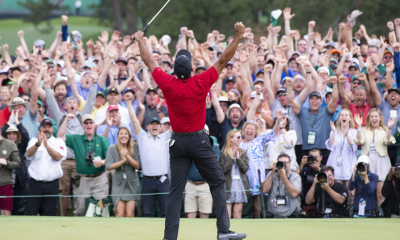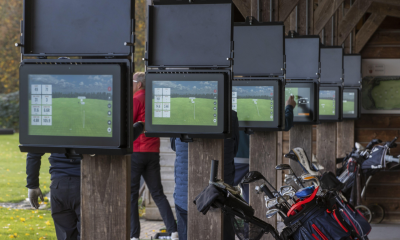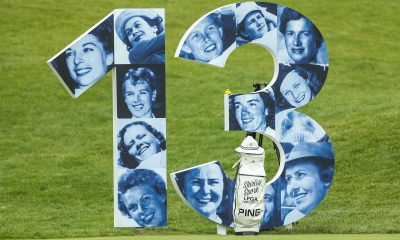Opinion & Analysis
Catching up with a pair of innovative companies ahead of the PGA Merchandise Show

Golf is a game of numbers and statistics. Average driver “carry” yardage. Total footage of putts holed per round. FedEx Cup rankings. Three holes up, two to play. Number of majors won. Course and personal record low scores. 14 golf clubs. 9- and 18-hole courses. Par 72. Holes-in-one. $5 Nassaus…
Appropriately, numbers will permeate the 2019 PGA Merchandise Show, the game’s annual industry summit, when it occurs later this month in Orlando (Jan. 22 Demo Day at Orange County National Golf Center; Jan. 23-26 PGA Show Exhibits at Orange County Convention Center).
This will be the 66th iteration of what has become an international golf business event. More than 1,000 golf companies and brands will be on display within nearly 10 miles of show aisles. One million square feet of interactive exhibit, product demonstration and industry presentation space. More than 40,000 PGA Professionals, manufacturing execs, VIP retailers, countless industry leaders and decision-makers.
As fascinating and insightful, fulfilling and frustrating, useful and sometimes useless golf numbers can be (most golfers couldn’t care less about how many dimples are on a golf ball), numerical figures don’t capture the human stories behind product innovations in the game, or articles for sale displayed at the PGA Merchandise Show.
Inspiration is a funny thing. You never know when it will strike. It’s often random, a common sense “Aha! Moment.” When it hits, fasten the seat belts, because vigorous, passionate action typically ensues.
Such was the case for ClickCaddie founder Scott Danielson and Kyle Klubertanz, who grew up together in Sun Prairie, Wisc. Their golf accessory core product was founded based on an idea that percolated during a round of golf in Fall 2017. They had their phones in the golf cart cup holders and were using them to play music and for course GPS information. After buying a round of drinks, they moved their phones to the front compartments where they clanged around, and they couldn’t hear their music or access their phones simply. “We realized there was no good place in the golf cart to put our phones; to use for GPS, music or golf-scoring apps,” said Danielson, ClickCaddie CEO. “We thought there had to be a better way.”
And so there was, they concluded, and it lay in the ubiquitous golf ball holders. “Every cart has them. They’re seldom used, and they’re the perfect mounting spot,” said Danielson.

Scott Danielson and Kyle Klubertanz, ClickCaddie co-founders
They started designing, and their first “proof of concept” consisted of a bulky phone holder bought off Amazon, with a golf ball duct taped to the bottom. It was around that time when magnetic phone attachments for cars caught their attention, which provided easy use and more accessibility. Fast forward through about seven designs and prototypes, multiple magnets, and ClickCaddie officially launched its patent-pending product design in April 2018.

ClickCaddie is a solution to the frustration its co-founders experienced when using their phones for multiple purposes while playing golf.
The silicone black cover can be custom branded and printed upon, adding an additional revenue stream through the promotional product arena (golf course logos, corporate branding, commemorative golf event gifts, etc.).
Danielson said the company and product has “taken off” since last April. “We have consumers that have used our product in 49 states – Alaska being the exception – we have sold thousands of units, and we launched on Amazon in time for the holiday gift buying season. As we move toward our second year, we are excited to showcase ClickCaddie at the PGA Merchandise Show. It’s very relatable to golfers and buyers across the country, and we’re excited to take that next step into growing the B2B side of our business, while continuing with our strategy to engage our end users for feedback.”

Necessity was the mother of invention for the founders of ClickCaddie.
While Danielson and Klubertanz founded ClickCaddie to make the golf experience more enjoyable peripheral to the core activity of playing the game, Sal Syed co-founded Arccos through his love for golf and technology, and his belief that golfers accessing real-time data, shot by shot, could help them improve.
First launched in late 2014, Arccos’ patented GPS-based hardware and software system have led to company products that include Caddie Smart Sensors, Caddie Smart Grips and the Arccos Driver. In short, “they combine the power of Artificial Intelligence and the Microsoft Azure cloud,” said Syed, Arccos CEO.
In lay terms, Arccos products have automatically recorded more than 60 million shots taken by golfers playing on courses worldwide. By analyzing each shot in real time, the company provides data-driven insights that help golfers improve their performance by eliminating guesswork and using statistical facts and feedback. This has led Arccos to stake claim as “the leading provider of big data, advanced analytics and machine learning insights for the global golf industry.”
“The PGA TOUR has done a great job of using advanced analytics to help its players practice and perform their best,” said Mike Downey, Director, Brand Partnership Engineering at Microsoft. “At other levels of the game, capturing the necessary on-course data has been a real challenge. Arccos has cracked that code and built a robust data set which they are deploying via the Microsoft Azure cloud to the benefit of golfers worldwide.”
That’s a lofty role in a roughly $80 billion industry, and Syed is changing the game for golfers of all skill levels, something particularly needed by non-professionals. But he didn’t set out to be a game-changer.
He was born and raised in Pakistan and didn’t start playing golf until age 14. Even then, he was more focused on other sports, namely tennis and cricket. Bitten by the golf bug after emigrating to America while attending Ohio Wesleyan University, Syed earned a BA in Computer Science and Mathematics and was captain of the tennis and cricket teams. His golf addiction was fueled by his ability to play for free at a course that the women’s tennis coach owned.
Syed selected Yale for his MBA in large part because it had one of America’s top-rated collegiate golf courses, a Golden Era of Golf Architecture masterpiece dating back to 1926.
The ongoing love affair with the game has led Syed to become a 1-handicap player, a Golf Digest Course Rater, and a genuine golf architecture nerd with true passion for CB Macdonald/Seth Raynor/Charles Banks designs (they collaborated on The Course at Yale). He has recorded four holes-in-one, three of which he credits to intelligence provided by Arccos data.

Arccos CEO Sal Syed married his love of golf and technology to co-found his company and its award-winning system and products.
During his MBA process, Syed became a Fellow at the Yale Entrepreneurial Institute, which set him on the path to combining his passions for golf and technology and to found Arccos. “We began with the idea for creating technology that tracks golf ball metrics to improve a player’s scores,” said Syed, “after a few trials, we realized it was very hard to do both technically and from a business perspective. We decided to change course and realized that if we could sense where you hit the ball and map it from there that we could be successful.”
Successful, indeed. A few Arccos accomplishments include:
- earning placement in Fast Company’s “World’s Most Innovative Companies 2018” list (ranked No. 3 in sports category globally)
- becoming the official A.I. and cloud computing partner of Microsoft
- partnering with Microsoft to develop Arccos Caddie, golf’s first A.I. platform
- garnering Golf Digest Editor’s Choice Award, Best Game Analyzer (2016, 2017, 2018)
And that’s the tip of the iceberg for Arcoss and Syed, whose vision is to connect every club and grip in golf and track every shot within five years. The company is on path to connect more than 50% of new golf clubs that come to market starting in Q1 2020, based on soon to be announced partnerships, according to Tom Williams, Arccos Executive Vice President of Strategic Partnerships.

Product Data Points include 2 milllion+ rounds played with the Arccos system, 100 million+ shots taken by Arccos users, 40,000 courses mapped, and 3.79 strokes (the average Arccos user first-year golf handicap improvement).
Syed named Arccos after the inverse cosine function, an element of advanced mathematics that is featured in the Arccos algorithm. According to MathOpenRef.com, the cosine function, along with sine and tangent, is one of the three most common trigonometric functions. In any right triangle, the cosine of an angle is the length of the adjacent side (A) divided by the length of the hypotenuse (H). Therefore, an inverse cosine function. . .
Say what?
Suffice it to say, if golf innovation were a swimming pool, Arccos is diving in the deep end, while ClickCaddie is frolicking in the kiddie pool. Nothing wrong with that. Just two vastly opposite ends of the golf invention spectrum, and a microcosm for what all can be found at PGA Merchandise Shows.
Buckle up!
Opinion & Analysis
The 2 primary challenges golf equipment companies face

As the editor-in-chief of this website and an observer of the GolfWRX forums and other online golf equipment discourse for over a decade, I’m pretty well attuned to the grunts and grumbles of a significant portion of the golf equipment purchasing spectrum. And before you accuse me of lording above all in some digital ivory tower, I’d like to offer that I worked at golf courses (public and private) for years prior to picking up my pen, so I’m well-versed in the non-degenerate golf equipment consumers out there. I touched (green)grass (retail)!
Complaints about the ills of and related to the OEMs usually follow some version of: Product cycles are too short for real innovation, tour equipment isn’t the same as retail (which is largely not true, by the way), too much is invested in marketing and not enough in R&D, top staffer X hasn’t even put the new driver in play, so it’s obviously not superior to the previous generation, prices are too high, and on and on.
Without digging into the merits of any of these claims, which I believe are mostly red herrings, I’d like to bring into view of our rangefinder what I believe to be the two primary difficulties golf equipment companies face.
One: As Terry Koehler, back when he was the CEO of Ben Hogan, told me at the time of the Ft Worth irons launch, if you can’t regularly hit the golf ball in a coin-sized area in the middle of the face, there’s not a ton that iron technology can do for you. Now, this is less true now with respect to irons than when he said it, and is less and less true by degrees as the clubs get larger (utilities, fairways, hybrids, drivers), but there remains a great deal of golf equipment truth in that statement. Think about it — which is to say, in TL;DR fashion, get lessons from a qualified instructor who will teach you about the fundamentals of repeatable impact and how the golf swing works, not just offer band-aid fixes. If you can’t repeatably deliver the golf club to the golf ball in something resembling the manner it was designed for, how can you expect to be getting the most out of the club — put another way, the maximum value from your investment?
Similarly, game improvement equipment can only improve your game if you game it. In other words, get fit for the clubs you ought to be playing rather than filling the bag with the ones you wish you could hit or used to be able to hit. Of course, don’t do this if you don’t care about performance and just want to hit a forged blade while playing off an 18 handicap. That’s absolutely fine. There were plenty of members in clubs back in the day playing Hogan Apex or Mizuno MP-32 irons who had no business doing so from a ballstriking standpoint, but they enjoyed their look, feel, and complementary qualities to their Gatsby hats and cashmere sweaters. Do what brings you a measure of joy in this maddening game.
Now, the second issue. This is not a plea for non-conforming equipment; rather, it is a statement of fact. USGA/R&A limits on every facet of golf equipment are detrimental to golf equipment manufacturers. Sure, you know this, but do you think about it as it applies to almost every element of equipment? A 500cc driver would be inherently more forgiving than a 460cc, as one with a COR measurement in excess of 0.83. 50-inch shafts. Box grooves. And on and on.
Would fewer regulations be objectively bad for the game? Would this erode its soul? Fortunately, that’s beside the point of this exercise, which is merely to point out the facts. The fact, in this case, is that equipment restrictions and regulations are the slaughterbench of an abundance of innovation in the golf equipment space. Is this for the best? Well, now I’ve asked the question twice and might as well give a partial response, I guess my answer to that would be, “It depends on what type of golf you’re playing and who you’re playing it with.”
For my part, I don’t mind embarrassing myself with vintage blades and persimmons chasing after the quasi-spiritual elevation of a well-struck shot, but that’s just me. Plenty of folks don’t give a damn if their grooves are conforming. Plenty of folks think the folks in Liberty Corner ought to add a prison to the museum for such offences. And those are just a few of the considerations for the amateur game — which doesn’t get inside the gallery ropes of the pro game…
Different strokes in the game of golf, in my humble opinion.
Anyway, I believe equipment company engineers are genuinely trying to build better equipment year over year. The marketing departments are trying to find ways to make this equipment appeal to the broadest segment of the golf market possible. All of this against (1) the backdrop of — at least for now — firm product cycles. And golfers who, with their ~15 average handicap (men), for the most part, are not striping the golf ball like Tiger in his prime and seem to have less and less time year over year to practice and improve. (2) Regulations that massively restrict what they’re able to do…
That’s the landscape as I see it and the real headwinds for golf equipment companies. No doubt, there’s more I haven’t considered, but I think the previous is a better — and better faith — point of departure when formulating any serious commentary on the golf equipment world than some of the more cynical and conspiratorial takes I hear.
Agree? Disagree? Think I’m worthy of an Adam Hadwin-esque security guard tackle? Let me know in the comments.
@golfoncbs The infamous Adam Hadwin tackle ? #golf #fyp #canada #pgatour #adamhadwin ? Ghibli-style nostalgic waltz – MaSssuguMusic
Podcasts
Fore Love of Golf: Introducing a new club concept

Episode #16 brings us Cliff McKinney. Cliff is the founder of Old Charlie Golf Club, a new club, and concept, to be built in the Florida panhandle. The model is quite interesting and aims to make great, private golf more affordable. We hope you enjoy the show!
Opinion & Analysis
On Scottie Scheffler wondering ‘What’s the point of winning?’

Last week, I came across a reel from BBC Sport on Instagram featuring Scottie Scheffler speaking to the media ahead of The Open at Royal Portrush. In it, he shared that he often wonders what the point is of wanting to win tournaments so badly — especially when he knows, deep down, that it doesn’t lead to a truly fulfilling life.
View this post on Instagram
“Is it great to be able to win tournaments and to accomplish the things I have in the game of golf? Yeah, it brings tears to my eyes just to think about it because I’ve literally worked my entire life to be good at this sport,” Scheffler said. “To have that kind of sense of accomplishment, I think, is a pretty cool feeling. To get to live out your dreams is very special, but at the end of the day, I’m not out here to inspire the next generation of golfers. I’m not out here to inspire someone to be the best player in the world, because what’s the point?”
Ironically — or perhaps perfectly — he went on to win the claret jug.
That question — what’s the point of winning? — cuts straight to the heart of the human journey.
As someone who’s spent over two decades in the trenches of professional golf, and in deep study of the mental, emotional, and spiritual dimensions of the game, I see Scottie’s inner conflict as a sign of soul evolution in motion.
I came to golf late. I wasn’t a junior standout or college All-American. At 27, I left a steady corporate job to see if I could be on the PGA Tour starting as a 14-handicap, average-length hitter. Over the years, my journey has been defined less by trophies and more by the relentless effort to navigate the deeply inequitable and gated system of professional golf — an effort that ultimately turned inward and helped me evolve as both a golfer and a person.
One perspective that helped me make sense of this inner dissonance around competition and our culture’s tendency to overvalue winning is the idea of soul evolution.
The University of Virginia’s Division of Perceptual Studies has done extensive research on reincarnation, and Netflix’s Surviving Death (Episode 6) explores the topic, too. Whether you take it literally or metaphorically, the idea that we’re on a long arc of growth — from beginner to sage elder — offers a profound perspective.
If you accept the premise literally, then terms like “young soul” and “old soul” start to hold meaning. However, even if we set the word “soul” aside, it’s easy to see that different levels of life experience produce different worldviews.
Newer souls — or people in earlier stages of their development — may be curious and kind but still lack discernment or depth. There is a naivety, and they don’t yet question as deeply, tending to see things in black and white, partly because certainty feels safer than confronting the unknown.
As we gain more experience, we begin to experiment. We test limits. We chase extreme external goals — sometimes at the expense of health, relationships, or inner peace — still operating from hunger, ambition, and the fragility of the ego.
It’s a necessary stage, but often a turbulent and unfulfilling one.
David Duval fell off the map after reaching World No. 1. Bubba Watson had his own “Is this it?” moment with his caddie, Ted Scott, after winning the Masters.
In Aaron Rodgers: Enigma, reflecting on his 2011 Super Bowl win, Rodgers said:
“Now I’ve accomplished the only thing that I really, really wanted to do in my life. Now what? I was like, ‘Did I aim at the wrong thing? Did I spend too much time thinking about stuff that ultimately doesn’t give you true happiness?’”
Jim Carrey once said, “I think everybody should get rich and famous and do everything they ever dreamed of so they can see that it’s not the answer.”
Eventually, though, something shifts.
We begin to see in shades of gray. Winning, dominating, accumulating—these pursuits lose their shine. The rewards feel more fleeting. Living in a constant state of fight-or-flight makes us feel alive, yes, but not happy and joyful.
Compassion begins to replace ambition. Love, presence, and gratitude become more fulfilling than status, profits, or trophies. We crave balance over burnout. Collaboration over competition. Meaning over metrics.
Interestingly, if we zoom out, we can apply this same model to nations and cultures. Countries, like people, have a collective “soul stage” made up of the individuals within them.
Take the United States, for example. I’d place it as a mid-level soul: highly competitive and deeply driven, but still learning emotional maturity. Still uncomfortable with nuance. Still believing that more is always better. Despite its global wins, the U.S. currently ranks just 23rd in happiness (as of 2025). You might liken it to a gifted teenager—bold, eager, and ambitious, but angsty and still figuring out how to live well and in balance. As much as a parent wants to protect their child, sometimes the child has to make their own mistakes to truly grow.
So when Scottie Scheffler wonders what the point of winning is, I don’t see someone losing strength.
I see someone evolving.
He’s beginning to look beyond the leaderboard. Beyond metrics of success that carry a lower vibration. And yet, in a poetic twist, Scheffler did go on to win The Open. But that only reinforces the point: even at the pinnacle, the question remains. And if more of us in the golf and sports world — and in U.S. culture at large — started asking similar questions, we might discover that the more meaningful trophy isn’t about accumulating or beating others at all costs.
It’s about awakening and evolving to something more than winning could ever promise.






















Norman
Jan 12, 2019 at 5:31 pm
Just what we need. More phones on the course. Thank you. Here’s a thought- put your phone down Donald. No one wants to hear your lame conversations or listen to your music.
Daniel Shepherd
Jan 13, 2019 at 12:59 pm
One person’s floor is another’s ceiling, Norman. Hope you find many fairways and greens. Cheers!
RV
Jan 11, 2019 at 7:30 pm
Big fan of my arccos. Looking forward to the weather warming up to get some rounds with my new irons and let arccos help dial in my distances.
Daniel Shepherd
Jan 13, 2019 at 1:01 pm
Hope the dialing in goes great, RV. Nothing like achieving improvement in the often bedeviling game we love. Cheers!
dj
Jan 11, 2019 at 6:53 am
“Suffice it to say, if golf innovation were a swimming pool, Arccos is diving in the deep end, while ClickCaddie is frolicking in the kiddie pool. ”
Really?
Daniel Shepherd
Jan 13, 2019 at 1:03 pm
That analogy doesn’t work for you, DJ? If you’re thinking it’s dissing ClickCaddie, it’s not. Rather, it was intended to show the spectrum of product innovation in golf – from Artificial Intelligence and algorithms to convenient phone access without spilling drinks on iPhones while listening to tunes. Cheers!
Merde
Jan 11, 2019 at 1:31 am
No, actually, golf is not a game of statistics. YOU stat addicts may think that, but it’s not.
All you do is hit a certain shot with a certain club and get it into the hole in as few shots as possible.
They didn’t need stats to do that when Hogan and Snead were playing. They just moved the ball forward and in.
Everybody stop wasting money on this stuff, you don’t need it
Dj
Jan 11, 2019 at 6:52 am
Your thinking is antiquated.
Daniel Shepherd
Jan 13, 2019 at 1:21 pm
I can respect that opinion, Merde, that’s precisely how the game should be consumed … however you like it best. But change and “progress” is inevitable; if it weren’t we’d still be using outhouses to relieve ourselves and Morse Code to communicate. That stated, there’s nothing wrong with your preference, just as there’s nothing wrong with those who value stats and tech to improve their game and golf experience. Cheers!
Kenny
Jan 17, 2019 at 1:47 pm
I don’t think I could survive in a world with out-houses or a cell phone. Technology is here to stay. Embrace it or risk being left behind.
Daniel Shepherd
Jan 18, 2019 at 4:55 pm
Good point Kenny. ClickCaddie doesn’t mean more cell phones on the course. They’re already there. It means more enjoyment for players who like to have their phone with them. Cheers!